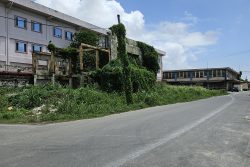Plants that are grown for the beauty of their leaves are just as important as those grown for their flowers. Flowering trees and shrubs flower (and fruit) at a definite time of the year, whereas trees and shrubs grown for their foliage or habit are generally a delight throughout the year. Attractive trees and shrubs which I have in or near to my relatively small garden include the Silk Oak (Grevillea robusta), Crotons of various colours (Codiaeum sp), the Cannon Ball tree (Couroupita sp), Ceylon Willow (Ficus benjamina), Draceana sanderiana, variegated Hibiscus (Hibiscus rosa sinensis), Acalyphas (Acalypha various sp), Cordyline, the leaves of which are dark green, bright red and yellow, some bougainvillea with variegated foliage. Asparagus plumosus and Cissus discolour. There are many more and I would suspect that many of you could add to this short list. Casting my eye down this list almost all of those plants included in it can be propagated quite easily by cuttings, and some very easily by means of seed. Those that come easily from seed include the Grevillea robusta (very easy) and the Cannonball tree. Seed from the Silk Oak will germinate in a week or so and can be used as a temporary attraction or as a permanent specimen tree. Seed from the Cannonball tree has to be extracted from the fruit, which can be a bit off-putting. Some years ago whilst spending some time in the Promenade Gardens I was strolling around and frequently came across fallen fruits of the Cannonball tree. The fruits are the size of actual cannonballs, and woe betide you if you are unfortunate enough to have one fall and bounce off your skull. Headaches for weeks. Anyway this fruit had fallen quite a few days before and was soft and mushy. It didn’t smell too good either. In the end I put it into a Survival carrier bag and my word, I had to have the car windows down for the journey home. It took quite some time to get the seed from the pulp but after I had worked on this for about an hour I had done so and washed it thoroughly. The pulp was thrown onto the compost heap. I kept two of the seeds for myself, and a friend of mine from Barbados took the remainder back to Montserrat, where they all germinated successfully over two weeks. Mine took about the same time.
I planted one of the young plants in the garden and realised very quickly that it was totally the wrong choice. The Cannonball tree is most certainly not the type of tree for the smallish garden. I know for a fact that my friend in Montserrat gave seedlings to some of his friends, so the tree was to be found in quite a few places, not only on that island but I suspect in St Vincent as well.
The rest of the shrubs on the list I gave you at the beginning of this week’s column can be grown well from cuttings. Crotons especially can be rooted from hardwood cuttings, and in that way can travel long distances without any harm. If you put them into pure sand and water them in well, they will start to root. New leaves will start to be produced first, but this does not mean new roots as well, so beware of lifting them too early.
Acalyphas are particularly beautiful shrubs for planting as screens, and grow very easily from cuttings. I always prepare cuttings without leaves as they do not lose water so much during the rooting process. You will find that once plants of Acalypha are well established, they will wilt in dry weather. I always try to leave the hose-pipe running on the ground for several hours so the plants get a really good drink. A bucketful is hardly adequate for a fully grown plant.
Take great care on the roads, improved as they are, and may your God go with you wherever you are in this great country.








